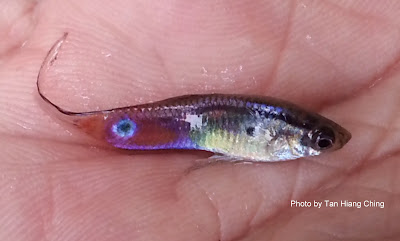Livebearers
Livebearers or livebearing tooth-carps are the common names used for the Poeciliidae family. They are originally distributed in America and Africa. They are primarily freshwater fishes with some species that can tolerate brackish water and at least one marine species. They differ from other fishes in term of their mode of reproduction where they give birth to young ones. They feed mainly on insects, other small invertebrates, and aquatic vegetation.
There are 44 genera and at least 350 species worldwide. A single species in Malaysian water are introduced from West Indies.
There are 44 genera and at least 350 species worldwide. A single species in Malaysian water are introduced from West Indies.
Scientific Name: Poecilia reticulata Peters, 1859
English Name: Guppy
Chinese Name | 鱼类中文名: 孔雀魚 (Kǒngquè yú)
Malay Name | Nama Melayu Malaysia: Ikan Gupi
Local Hokkien: Beekok Hu, Peacock
Thai Name | ชื่อสามัญภาษาไทย: ปลาหางนกยูง (Plā h̄āng nkyūng)
Main Identification Features: Top of head scaled. Caudal fin rounded. Male has obvious color patterns, ornamental caudal and dorsal fins, and a slender modified anal fin. Female is larger and grey in color.
Size: Maximum standard length 5 cm.
Habitat and Ecology: Native to parts of the Caribbean and northern South America, but it has been widely introduced throughout temperate and tropical regions. Occurs in wide variety of habitats ranging from from highly turbid water at low elevations to mountain streams at high elevations. Feeds on zooplankton, small insects, larvae and detritus.

Male

Female
English Name: Guppy
Chinese Name | 鱼类中文名: 孔雀魚 (Kǒngquè yú)
Malay Name | Nama Melayu Malaysia: Ikan Gupi
Local Hokkien: Beekok Hu, Peacock
Thai Name | ชื่อสามัญภาษาไทย: ปลาหางนกยูง (Plā h̄āng nkyūng)
Main Identification Features: Top of head scaled. Caudal fin rounded. Male has obvious color patterns, ornamental caudal and dorsal fins, and a slender modified anal fin. Female is larger and grey in color.
Size: Maximum standard length 5 cm.
Habitat and Ecology: Native to parts of the Caribbean and northern South America, but it has been widely introduced throughout temperate and tropical regions. Occurs in wide variety of habitats ranging from from highly turbid water at low elevations to mountain streams at high elevations. Feeds on zooplankton, small insects, larvae and detritus.

Male

Female